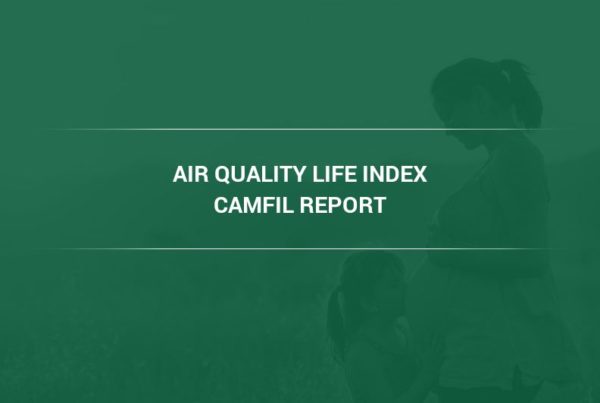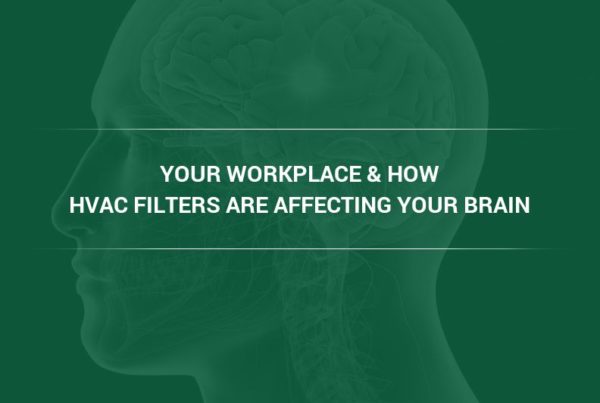Each year since the implementation of the Clean Air Act in 1970, the EPA releases its Annual Air Report, highlighting the nation’s progress in the mission of reducing levels of hazardous pollutants in the air.
In this article, air quality experts from global air filtration industry leader Camfil explain the findings of the EPA’s Annual Air Report and what it means for Americans.
United States Air Pollution Follows a Downward Trend
The data from the Annual Air Report shows that key pollutants have been declining, both overall since the introduction of the Clean Air Act and year-over-year. It’s important to note that at the same time these key pollutants have declined, the US economy has grown and overall energy usage has increased. This demonstrates actions taken to provide clean and healthy air do not hamper economic growth.
Since 1990, the EPA has observed the following decreases in various pollutants:
- Carbon Monoxide (CO) 8-Hour, 79%
- Nitrogen Dioxide (NO2) Annual, 61%
- Nitrogen Dioxide (NO2) 1-Hour, 54%
- Ozone (O3) 8-Hour, 21%
- Particulate Matter 10 microns (PM10) 24-Hour, 32%
- Particulate Matter 2.5 microns (PM2.5) Annual, 37% (from 2000)
- Particulate Matter 2.5 microns (PM2.5) 24-Hour, 33% (from 2000)
- Sulfur Dioxide (SO2) 1-Hour, 91%
Though total emissions of key pollutants have dropped by 78% since the very first Annual Air Report, the presence of dangerous air pollutants has not been completely eliminated, which still has notable effects on human health and the environment. In fact, the average American would see an extension of approximately two years in their lifespan if air pollution concentration was reduced to limits recommended by the World Health Organization (WHO).
EPA Report Highlights Dangerous Effects of Air Pollution on Health and Environment
As explained by the EPA’s report, there are six pollutants that
Carbon monoxide (CO):
- Health effects: Exposure to carbon monoxide reduces the amount of oxygen that reaches vital organs and other tissues, including the brain and heart because the molecules bind to a form of heme in the blood. It is well-known that exposure to large amounts of carbon monoxide can be fatal, but even in small amounts, carbon monoxide can lead to hospitalization in individuals with heart disease.
- Environmental effects: Although carbon monoxide itself is not considered a greenhouse gas, the EPA notes that it contributes to the formation of carbon dioxide and other greenhouse gasses when emitted into the atmosphere.
Lead (Pb):
- Health effects: Both long and short-term exposure to lead in the air are linked to severe consequences. Lead may harm nervous system development in children, leading to learning deficits, behavioral issues, and even lower IQs. In adults, lead exposure contributes to poor cardiovascular health and may increase blood pressure and even cause heart disease.
- Environmental effects: When lead is released as air pollution, it invades water supplies and soil deposits, leading to decreased growth and lower rates of reproduction in plants and animals.
Ozone (O3):
- Health effects: Breathing in ozone can immediately lead to a reduction in lung function, producing symptoms such as coughing, shortness of breath, migraines, and dizziness. This can aggravate existing respiratory conditions, such as asthma and emphysema, leading to increased hospital admissions in patients affected by such conditions. Ozone exposure is also associated with premature mortality from respiratory causes.
- Environmental effects: Atmospheric ozone is essential for life on earth to thrive because it protects the planet from the sun’s harsh ultraviolet rays. Ground-level ozone, on the other hand, has a variety of negative effects on the environment. Ozone damages plants by slowing growth and reproduction, reducing photosynthesis, injuring leaves, and reducing crop yields. The damage that ozone causes plants may subsequently change the structure of ecosystems, leading to reduced biodiversity and redacted plant uptake of CO2.
- Related post: The Hidden Hazards Of Indoor Air Pollution From Ozone
Nitrogen oxides (NOx):
- Health effects: Nitrogen oxides are a group of highly reactive gasses. Nitrogen dioxide is the most prominent health concern of this group. Like many pollutants, short-term exposure to nitrogen dioxide is known to aggravate existing respiratory diseases such as asthma and COPD, which can lead to hospitalization. In the long term, nitrogen dioxide exposure can contribute to the development of asthma and increase susceptibility to respiratory infections.
- Environmental effects: Reactions between nitrogen oxides and volatile organic compounds form ozone while reactions between nitrogen oxides and other compounds form particle pollution. Deposits of nitrogen oxide acidify soils and surface waters, which affects the growth of plants, including crops, and the health of both wildlife and livestock animals.
Sulfur oxides (SOx):
- Health effects: Sulfur dioxide is the most commonly occurring sulfur dioxide in the atmosphere as well as the one most closely linked with human health. Short-term exposure to sulfur dioxide increases symptoms of asthma. Increased ambient sulfur dioxide levels are linked to emergency department admissions for respiratory illnesses. This effect is especially pronounced for at-risk populations of his children older adults and those with pre-existing health conditions
- Environmental effects: Sulfur oxides react with ammonia and other compounds to form particle pollution, which has a range of environmental consequences. Deposits of sulfur oxides also acidify soils and contribute to mercury methylation of wetlands. At high concentrations, sulfur dioxide causes injury to vegetation and decreases biodiversity in both aquatic and terrestrial systems.
Particulate matter:
- Health effects: Much of the body of research examining the effects of air pollution on human health looks at the effects of particulate matter, especially fine particulate matter, or PM2.5, which encompasses any particles with a diameter of 2.5 microns or less. Particulate matter is most closely linked to respiratory and cardiovascular harm, including symptoms of respiratory irritation (coughing, sneezing, sore throats, runny noses, and itchy eyes), and cardiovascular issues such as heart attacks and strokes.
- Environmental effects: Particulate matter is responsible for the hazy conditions and reduced visibility associated with air pollution. Particulate matter is known to be carried by the wind across long distances, where it settles on soil and on the surface of bodies of water. As a result of this settling, lakes and streams become acidic, coastal waters experience a shift in nutrient balance, sensitive crops and forest plants are damaged, and the diversity of ecosystems is diminished.
- Related post: Older Americans at Risk – Low Levels of Particulate Matter Can Be Deadly
Improving Indoor Air Quality (IAQ) in Polluted Areas
The EPA’s Annual Air Report shows that levels of key air pollutants are decreasing over time, leading to better ambient air quality on average across the United States.
However, there are still many areas in which residents’ everyday lives are impacted by poor air quality. While the effort to reduce air pollution at the source and improve air quality for all Americans is an ongoing team effort, public, commercial, and residential buildings can make large improvements in indoor air quality through the implementation of the right air filtration system. Evaluating each application and installing the proper air filtration solution can actually lower overall operating cost, particularly when it comes to energy usage.
Most HVAC systems come equipped with a filter that protects the equipment from being damaged by debris, but these filters are not designed to protect human lungs from finer particle pollution. Furthermore, HVAC filters rarely target gaseous pollutants (such as ozone, nitrogen oxides, sulfur dioxide, and carbon monoxide); MERV-rated filters are designed to capture particles, not to trap gasses.
With an air purifier such as Camfil’s City M, which works independently of the building’s HVAC system, building managers can target both gaseous and particulate pollutants for optimized indoor air quality.
To find out more about what air filtration solutions work best for your building, contact a local Camfil representative.
About Camfil Clean Air Solutions
For more than half a century, Camfil has been helping people breathe cleaner air. As a leading manufacturer of premium clean air solutions, we provide commercial and industrial systems for air filtration and air pollution control that improve worker and equipment productivity, minimize energy use, and benefit human health and the environment. We firmly believe that the best solutions for our customers are the best solutions for our planet, too. That’s why every step of the way – from design to delivery and across the product life cycle – we consider the impact of what we do on people and on the world around us. Through a fresh approach to problem-solving, innovative design, precise process control, and a strong customer focus we aim to conserve more, use less and find better ways – so we can all breathe easier.
The Camfil Group is headquartered in Stockholm, Sweden, and has 31 manufacturing sites, six R&D centers, local sales offices in 35+ countries, and about 5,200 employees and growing. We proudly serve and support customers in a wide variety of industries and in communities across the world. To discover how Camfil USA can help you to protect people, processes and the environment, visit us at www.camfil.us/
##
Media Contact:
Lynne Laake
Camfil USA Air Filters
T: 888.599.6620
E: Lynne.Laake@camfil.com
F: Friend Camfil USA on Facebook
T: Follow Camfil USA on Twitter
Y: Watch Camfil Videos on YouTube
L: Follow our LinkedIn Page
Sources:
https://gispub.epa.gov/air/trendsreport/2022/#air_pollution
https://www.epa.gov/newsreleases/epa-releases-annual-air-report-highlighting-trends-through-2021



